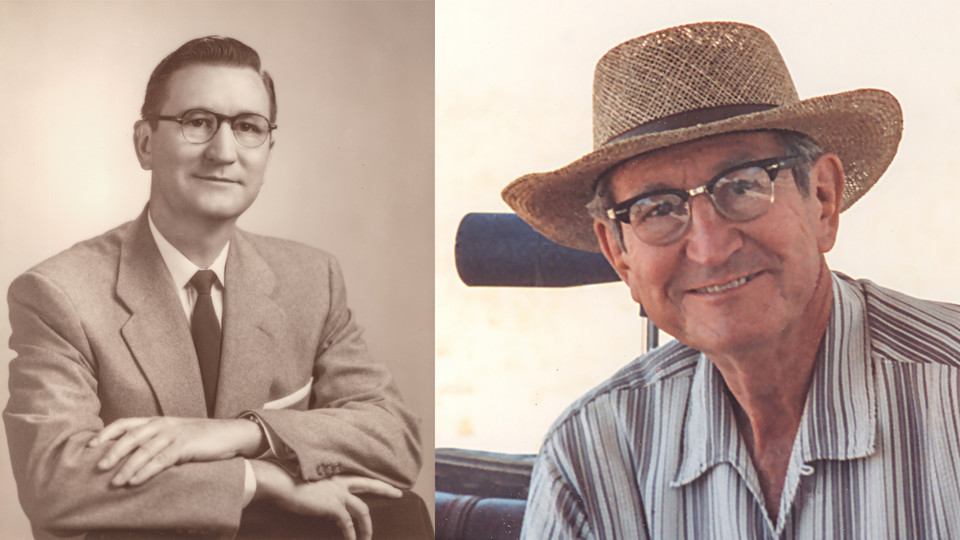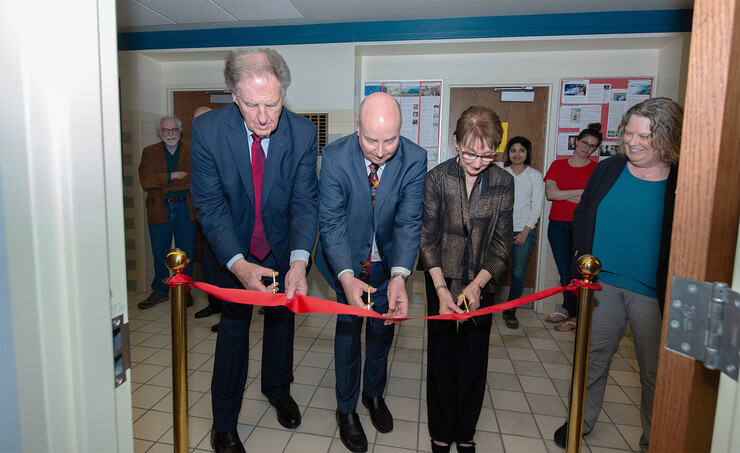· 4 min read
Earth and Atmospheric Sciences celebrates computing lab

Water came to define much of Jerome J. Wright’s life.
It shaped the sands of Omaha Beach, where he went ashore shortly after Allied forces took it on D-Day. As a hydrogeologist, it grounded much of his research and teaching. And its impending shortages occupied his thoughts even into retirement.
Wright’s daughter and grandson relayed memories of the late University of Nebraska–Lincoln alumnus during an April 26 celebration of the Bessey Hall lab that now bears his name.
Previously known as Room 214, the Jerome J. Wright and Alumni Computation and Visualization Laboratory now houses 20 industry-grade computer stations and multiple nods to prominent graduates from Nebraska’s Department of Earth and Atmospheric Sciences.
“I thank you all so much for this beautiful, beautiful lab,” Wright’s daughter, Bunny Gardner, said to assembled faculty, students and alumni of the department. “My father would be so thrilled.”
Virginia Long Maples, Wright’s sister-in-law, bequeathed a substantial gift toward the lab’s completion to honor her brother-in-law. Wright was a Nebraska grad who earned a bachelor’s in geology in 1941 and, on returning from World War II, a master’s in 1947.
The nature of Wright’s work with the U.S. Geological Survey and as a faculty member at the University of Arizona makes the lab a fitting tribute, said Tracy Frank, chair and professor of the Department of Earth and Atmospheric Sciences.
“His research focused on complex fluid flow through porous media, and today, that sort of work relies heavily on computational and visualization facilities like we have here today,” Frank said. “So our lab is aptly named.”
Featuring software recently donated by a geological engineering company, the lab will familiarize students with the sorts of 3D modeling and big-data computation that employers will expect them to know upon graduating, Frank said. Because those skills apply to numerous geoscience-related fields — Frank specifically cited energy exploration and water mapping — Nebraska graduates should also benefit from a broader range of professional opportunities going forward.
“Exploration nowadays is going very much into large-volume, high-capacity datasets,” said Christopher Fielding, professor of Earth and atmospheric sciences. “If you can’t process that volume of data in a reasonable time frame, you’re not in the game. That’s the difference between what we have had and what we’ve now got. It’s a quantum leap, really.”
The refurbished space will also function as a learning commons, with whiteboard-coated walls and lounge furniture aimed at transforming the second-floor lab into a hub for both undergraduate and graduate students.
“We’ll have the opportunity, every day, to see how this lab is going to help our students research and learn and collaborate while forming the lifelong friendships and preparing for careers that university is supposed to give them,” said Cara Burberry, associate professor of Earth and atmospheric sciences. “We’re hoping that it will become the center of the department. And that, I think, is what it’s becoming for some of the cohorts of undergraduates.”
That focus on students and the pursuit of knowledge personifies Wright’s life and spirit, said grandson Eric Gardner.
“I just think there could be absolutely no better type of facility than this lab here to be named after my grandfather,” he said. “Because when you talk about the integrity of science and observation and so forth — he was all about that.
“These computers obviously were not in existence when he was teaching in the 1960s and ’70s, but I know he would embrace this.”








